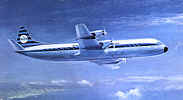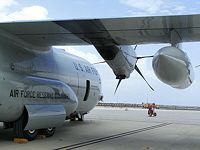

Rick Clarke
Air Classics Magazine
Rick Clarke was kind enough to contact me and compliment me on this site. Almost made be blush by referring to my staff! (Sometimes I do wish I had one, but most times I'm glad I don't.) He has had a very interesting job: Flying Constellations into the eye of a hurricane for weather observations.
I had only read actual descriptions of this in two books, Herman Wouk's Slattery's Hurricane and Desmond Bagley's Wyatt's Hurricane. Just like you'd expect, the danger is underplayed by Wouk while Bagley milks it for all the excitement he can get, and then, just possibly, maybe some. I was therefore delighted to be able to get it from the horse's mouth:
My flying was into typhoonswhile the east coast squadrons flew into hurricanes. They were the Hurricane Huntersand we were the Typhoon Trackers. We took pride in that since there always were more typhoons and they were bigger than hurricanes on average............... LOTS more warm water out in the Pacific. Of course this was professional rivalry and joking, but it is a distinction that we were careful to make. Yes, a typhoon, a hurricane and a cyclone are the same phenomenon, but it's still a point of honor among us fliers. It all has to do with the part of the world: Typhoons west of the 180th meridian, hurricanes east of that and cyclones in the Indian Ocean. In fact, very rarely, a typhoon will last long enough and curve eastward enough that it will change from a typhoon to a hurricane as it crosses the 180th meridian way out there in the Pacific. It's only a change of words and a piece of meteorology trivia. |
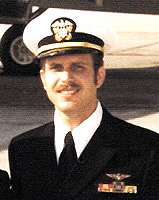
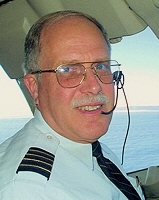
Rick Clarke, then and now
So was and is it dangerous? Well, you could ask that about crossing the street in Rome......and get various answers. I think the best answer is that it was dangerous when it was experimental and it is dangerous if the crew does not take care in doing things right. However, the crews all learn this by
on the job training (OJT)such that you never have a crew ofrookies. The radar is key to success, too. I suppose the point is to do things right ----- while depending on a sturdy and reliable airframe and set of engines. Yes, there is risk to it, but it's managed pretty well. One gets accustomed to the job and while there's natural apprehension if you're one of the relief crew onboard with nothing to do during the penetration, it's pretty minor. The crew that's busy at the various duty stations is too busy to think of anything except coping with the situation. Perhaps it's a gamble, but it's a gamble with the deck stacked in your favor. You also have the comfort of knowing that if anything goes wrong, you won't have to experience it for very long. :-)
KLM Lockheed Electra
civil version of the P-3 OrionNow back to the airplane. Our weather Connies were reinforced at key points of the fuselage and wings such that you would see
doublerpanels in places that the civil Connies would only have smooth metal. One of the strengths of the Connie was its flexibility; much like the child's tale of the unbending oak breaking, vs the yielding wheat bending and flexing. When one sat in the galley area and watched out the windows just forward of the propellers, you would have a good view of the tip tank and wing tip. It was normal, in turbulence, to see the tip tank disappear at the top of the window, then descend to below the bottom of the window. The Electra based P-3 Orion that replaced the Connie had a notoriously stiff wing such that it did not flex and the crews of the P-3s noted that the ride in that beast was jarring in the extreme. The Connie's turbulence response in most cases was smoother. Only extreme turbulence would really shake the plane hard. As to the C-130 Hercules, well it has a relatively stiff wing and wing spar cracking problems. When we flew the typhoons, our Connies went into the "eye" at between 1,000 ft and 500 ft. while the Air Force C-130s went in at 18,000 ft. In all cases we both used our radar to avoid the bad weather, but their ride was better - that was good as our radar was many times superior to theirs. We had the 20 foot APS-20 radar dish in that belly radome while they had only the small, forward facing radar dish in the nose of the C-130.
Lockheed C130 Hercules
on Curaçao Hato airportThe job was and is dangerous on occasion, but hasn't been costly despite that. Way back in the late 40s the Navy lost a PB4Y Privateer to a typhoon in their early days of storm flying and the Air Force lost a B-29 or B-50. It really was an experiment back then. In the late 50s the Navy lost a P2V Neptune in an Atlantic hurricane. This happened in the time that VW-4 (the Navy Hurricane Hunter squadron in Jacksonville, FL) was transitioning from the P2V to the WV-2 Constellation. The P2V was an incredibly strong airplane but less capable both in radar and performance. One of the pilots I flew with had been in the Connie that was relieved by the Neptune on station. The Connie crew, as it left the area of the storm, noted that they saw the Neptune on their radar headed toward an area of
hookradar returns. Thosehooksdenote the most severe sort of weather of thunderstorms. In all likelihood the Neptune flew into weather that no plane could survive. As they were at low altitude,wind shear,downburstsand plain old turbulence all are possibilities for their demise.
when it does go wrongA few years later VW-4 nearly lost a Connie in hurricane turbulence. The damage was so bad that the plane never flew again after it limped back to Puerto Rico. It became a source of spare parts. The pilot I mentioned above was on that Connie. People got hurt onboard, but they got home. That makes one very affectionate about one's airplane and its design.
Of course the Air Force has lost a C-130 to a hurricane back in the 90s. As no one was out there with them, no one knows what happened. There are lots of possibilities but no facts on that loss. So there you have the U. S. experience - 4 complete losses and one near loss since the 1940s. Pretty good, considering, I'd say. Our Typhoon Tracker squadron (VW-1) based on Guam had no losses, but twice we did have the tip tank and a bit of wing ripped off in turbulence.
The Connie was a forgiving and tolerant machine.
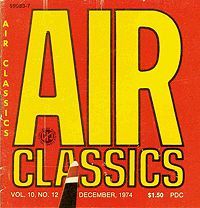
Rick Clarke's article
Typhoon Hunting
in Air Classics Magazine
check this out:
free, light alternative to the bloated Adobe viewer
More Famous Aircraft


model drawings available from
Modelbouwers
SEARCH this site or the Web

copyright notice
all material on this site, except where noted
copyright © by , curaçao
reproduction in any form for any purpose is prohibited
without prior consent in writing
